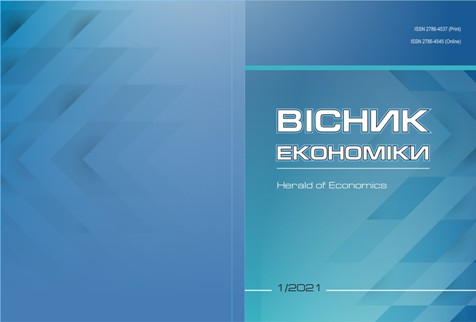Impact of international migration on the economy of Ukraine
DOI:
https://doi.org/10.35774/visnyk2024.01.168Keywords:
internally displaced persons (IDPs), international migration, refugees, re-emigration, post-war reconstructionAbstract
Introduction. In today’s modern world, people migrate in search of work or economic opportunity, to join family or to study. Also, the population migrates to escape conflict, persecution or large-scale violations of human rights. In addition, population migration is a response to the adverse effects of climate change, natural disasters or other environmental factors. As a result, the 2030 Agenda for Sustainable Development recognizes the positive contribution of migrants to the inclusive growth and sustainable development of regions.
The number of citizens of Ukraine who were forced to leave the territory of the country due to the full-scale invasion of Russia can be compared with the depopulation during all the years of Ukraine’s independence. The solution to the migration crisis and the return of Ukrainians to their homes should become the main focus of the common post-war policy of Ukraine and the EU.
Research Objective. The aim of the study is the systematic examination and analysis of the impact of international migration on the economy of Ukraine in order to develop recommendations on the key principles of the economic reintegration of Ukrainian refugees.
Methods. The study employs economic-statistical analysis to estimate the actual number of IDPs and returnees. Additionally, general scientific and empirical approaches, as well as tools from the field of economic science, are utilized. Methods such as synthesis, comparison, aggregation, and grouping are also applied to enhance the comprehensiveness of the research.
Results. Theories of international migration and the incentives of migration flows are studied. The role of conflicts in migration processes and their impact on the category of internally displaced persons is analyzed, the level of influence of Ukrainian migrants on the EU economy is evaluated. The recommendations regarding the key principles of the economic reintegration of Ukrainian refugees are substantiated.
Perspectives for further research consist in the research of the reasons for the integration of Ukrainian migrants in the recipient-countries in order to develop mechanisms for the return of Ukrainians home and forecast the period of economic recovery, integration and convergence of the country with the EU.
References
Barnett, G., Nam, Y. (2023). A network analysis of international migration: Longitudinal trends and antecedent factors predicting migration. Global Networks,6. Retrieved from https://doi.org/10.1111/glob.12455 [in English].
Massey, D. S. (2023). The Shape of Things to Come: International Migration in the Twenty-First Century. In: Lerpold, L., Sjöberg, Ö., Wennberg, K. (eds) Migration and Integration in a Post-Pandemic World. Palgrave Macmillan, Cham. 433 p. Retrieved from https://doi.org/10.1007/978-3-031-19153-4_2 [in English].
Tsegay, S. M. (2023). International Migration: Definition, Causes and Effects. Genealogy, 7, 61. Retrieved from https://doi.org/10.3390/genealogy7030061 [in English].
Adamson, F., Chung, E., Hollifield, J. (2023). Rethinking the migration state: historicising, decolonising, and disaggregating. Journal of Ethnic and Migration Studies, 12. Retrieved from https://doi.org/10.1080/1369183X.2023.2269769 [in English].
Rostetska, S., Shvets, S., Ilkiv, O. (2023). Formation of a new paradigm of global political and migration processes under the influence of military activities in Ukraine. Baltic Journal of Economic Studies, 9(5), 241-251. Retrieved from https://doi. org/10.30525/2256-0742/2023-9-5-241-251 [in English].
Massey, D. S., Arango, J., Hugo, G., Kouaouci, A., Pellegrino, A., Taylor, J. E. (1993). Theories of International Migration: A Review and Appraisal. Population and Development Review, 19(3): 431–466. Retrieved from https://doi. org/10.2307/2938462 [in English].
Stark, O., Bloom, D. (1985). The new economics of labor migration. American Economic Review, 75(2):173-178. Retrieved from https://www.jstor.org/ stable/1805591 [in English].
Riosmena, F., Wong, R., Palloni, A. (2019). Migration Selection, Protection, and Acculturation in Health: A Binational Perspective on Older Adults. Demography, 50(3):1039-1064. Retrieved from https://doi.org/10.1007/s13524-012-0178-9 [in English].
Arango, J. (2000). Explaining migration: a critical view. International social science journal. 52(165): 283-296. Retrieved from https://doi.org/10.1111/1468-2451.00259 [in English].
Akokpari, J. K. (1998). The state, refugees and migration in Sub-Saharan Africa. International Migration, 36, 211–234. Retrieved from https://library.fes.de/libalt/ journals/swetsfulltext/5231763.pdf [in English].
Collier, P. (1999). On the economic consequences of civil war. Oxford economic papers, 51, 168–183. Retrieved from http://www.jstor.org/stable/3488597 [in English].
Dunne, J., Tian, N. (2019). Costs of civil war and fragile states in Africa. Review of Development Economics, 23, 1220–1237. Retrieved from https://doi.org/10.1111/ rode.12612 [in English].
Murdoch, J., Sandler, T. (2002). Civil wars and economic growth: A regional comparison. Defense and Peace Economics, 13, 451–464. Retrieved from https:// doi.org/10.1080/10242690214336 [in English].
International Organization for Migration. (2023). DTM Ukraine Returns Report. General Population Survey. IOM, Ukraine. R14. 15 p. Retrieved from https://dtm. iom.int/sites/g/files/tmzbdl1461/files/reports/IOM_Gen%20Pop%20Report_R12_ RET_Final.pdf [in English].
ICMPD Migration Outlook. (2023). Eastern Europe and Central Asia. International Centre for Migration Policy Development. 6 Issue, 31. Retrieved from https:// www.icmpd.org/file/download/59104/file/230215_ICMPD_Migration_Outlook_ EasternEuropeCentralAsia_2023_final.pdf [in English].



